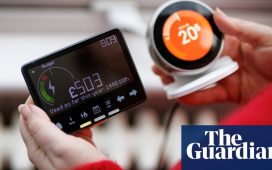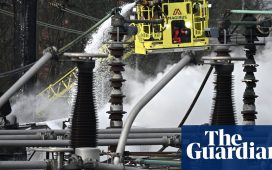In an industrial park in south Wales, start-up Protium uses renewable electricity to power a small electrolysis plant it opened earlier this year to extract hydrogen from water, producing up to 35kg of the gas every day.
The product, known as “green hydrogen”, is a key part of the UK’s plans to decarbonise, hailed by its promoters as a revolutionary alternative to fossil fuels as the gas does not produce carbon dioxide when burnt.
As governments look to reduce their emissions they are eyeing the low-carbon hydrogen as a clean alternative fuel for energy-intensive industries, transport and power stations.
The UK is looking to establish itself as a world leader in the production of low-carbon hydrogen but scaling up is difficult given constrained global supply chains, limited green electricity supplies, and the need to stimulate demand for hydrogen in the absence of a plentiful, cheap supply of the gas.
The 100KW plant in Wales is one of just two small facilities to open this year, bringing the UK’s total green hydrogen production capacity to 5MW, according to data provided by RenewableUK’s EnergyPulse, representing just 0.1 per cent of the 5GW the government wants up and running by 2030.
“We are quite unusual in that we’re a green hydrogen company that does actually produce green hydrogen,” said Chris Jackson, chief executive of Protium, referring to the proliferation of projects yet to become reality.
In an attempt to kick-start the nascent industry, the government is expected for the first time to offer an as yet undisclosed level of state guarantees to developers in the next few weeks to build up to 250MW of green hydrogen capacity “subject to affordability and value for money” with the first projects coming online by 2025.
Each contract will provide developers with revenue guarantees for their projects. Further subsidy rounds will follow, designed to put the UK halfway along the path to hitting its overall low-carbon hydrogen production target of 10GW by the end of the decade. The other half is expected to come from so-called “blue hydrogen” plants, which store emissions released when extracting the fuel from natural gas.
“The [green hydrogen contract awards] are a defining moment for the industry,” said Laurie Heyworth, policy analyst at RenewableUK, the trade group. “I think it really is dependent on these projects being successful, reaching final investment decisions and being constructed in the next few years.”
In a process that began last year, 17 projects with a total capacity of 262MW backed by developers including oil major BP and utilities SSE and EDF, are vying for taxpayers’s support.
However, the withdrawal of three projects at an earlier stage of negotiations this summer illustrated the difficulties of creating a new industry almost from scratch.
Among them was the largest project, the 100MW Gigastack, which is a joint development by US refining giant Phillips 66 and Ørsted, the world’s largest offshore wind developer. A spokesman said the project was on “pause . . . [with] further project maturation and supply chain development required”.
UK petrochemicals producer Ineos also pulled its planned facility in Runcorn, Cheshire, complaining the government’s timeline to get it up and running by mid-2026 was “unrealistic” given supply chain challenges and the project’s complexities.
“Significant government funding would be required” to take the project forward, a company spokesman added.

Analysts warn that the supply chain pressures and the need to create a demand for the fuel could leave the UK trailing other countries with more attractive low-carbon hydrogen support schemes.
“We’re in an environment of significant cost increases and companies are looking carefully at the investment decisions that they’re making,” said Molly Iliffe, global head of hydrogen at consultancy Baringa.
At the end of last month, the EU announced it was inviting bids for an initial €800mn of support available to clean hydrogen producers through the newly created European Hydrogen Bank. The bloc already has binding targets in place to force heavy industry to increase its use of low-carbon hydrogen.
Meanwhile, in October the US announced $7bn in taxpayers’ support to develop seven regional “clean hydrogen hubs” as part of President Joe Biden’s Inflation Reduction Act, with an extra $1bn set aside for demand-side support “to drive innovative end-uses of clean hydrogen.”
“We’re not working in a vacuum,” said Celia Greaves, chief executive of the Hydrogen Energy Association, the UK trade group. “We need to be moving further and faster if we want to make the most of the great expertise and companies that we have.”
Investing in new production capacity has been challenging given the limited demand. Critics of the UK scheme said it was not doing as much as the EU in terms of encouraging the creation of a customer base for low-carbon hydrogen. For example, the UK government scheme only requires developers to have memorandums of understanding in place with prospective buyers.
Integrated oil and gas majors like BP, which is developing a large green hydrogen project in Teesside, believe they can do so by leveraging their existing customer base. “The aim is to try to create something that knits together what we’re doing with mobility with hydrogen production and in future with our offshore wind business,” said Andy Lane, BP’s UK vice-president for hydrogen and carbon capture.
But smaller companies are left having to create a customer base from scratch. Protium’s product is being used in trials of hydrogen-powered buses in south Wales. “We believe that the way that you build the green hydrogen ecosystem is the way that you’ve built every other energy transition,” Jackson said. “You start small and then you build up.”
Asked if it should do more to support UK producers, the government said Britain was a “world leader” in developing low-carbon hydrogen. It added that hitting its initial 10GW production target would support “more than 12,000 jobs and up to £11bn of private investment across the UK”.









